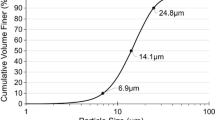Abstract
Characterization of thermal debinding of boron carbide green samples in an ambient atmosphere with the temperature range of 350 to 500 °C was investigated. Binders are easier to remove in the ambient atmosphere because of the continuous oxygen supply. XRD results show that the diffraction peak of B2O3 appears in debound samples above 350 °C. The diameter and mass of the samples display no significant changes when the debinding temperature is below 400 °C. Moreover, glassy phases are not observed through the analysis on fracture surfaces by scanning electron microscope and debound samples have enough strength for the handling. The linear shrinkage and mass growth of debound samples improve markedly with increasing debinding temperature. Glassy phases are observed when debinding temperature is above 500 °C. Furthermore, the linear shrinkages of these sintered samples debound in the ambient atmosphere below 400 °C are about 18 % which are consistent with the sintered samples debound beforehand in Ar. Therefore, thermal debinding in an ambient atmosphere under suitable temperature (400 °C) is feasible for powder injection-molded B4C material.
Similar content being viewed by others
References
Liu CX, Sun JL (2010) Erosion behavior of B4C-based ceramic composites. Ceram Int 36:1297–1302
Lee H, Speyer RF (2003) Pressureless sintering of boron carbide. J Am Ceram Soc 86:1468–1473
Yazdani A, Salahinejad E (2011) Evolution of reinforcement distribution in Al–B4C composites during accumulative roll bonding. Mater Des 32:3137–3142
Deng JX (2005) Erosion wear of boron carbide ceramic nozzles by abrasive air-jets. Mater Sci Eng A Struct 408:227–233
Cho N, Bao Z, Speyer RF (2005) Density and hardness-optimized pressureless sintered and post-hot isostatic pressed B4C. J Mater Res 20:2110–2116
Sharifi EM, Karimzadeh F, Enayati MH (2011) Fabrication and evaluation of mechanical and tribological properties of boron carbide reinforced aluminum matrix nanocomposites. Mater Des 32:3263–3271
Baharvandi HR, Hadian AM, Abdizadeh A, Ehsani N (2006) Investigation on addition of ZrO2–3 mol% Y2O3 powder on sintering behavior and mechanical properties of B4C. J Mater Sci 41:5269–5273
Suri AK, Subramanian C, Sonber JK, Murthy TSR (2010) Synthesis and consolidation of boron carbide: a review. Int Mater Rev 55:4–40
Piotter V, Mueller T, Plewa K, Prokop J, Ritzhaupt-Kleissl HJ, Hausselt J (2010) Manufacturing of complex-shaped ceramic components by micropowder injection molding. Int J Adv Manuf Technol 46:131–134
Tan LP, Joshi SC, Yue CY, Lam YC, Hu X, Tam KC (2003) Effect of shear heating during injection moulding on the morphology of PC/LCP blends. Acta Mater 51:6269–6276
Li DX, Hou HT, Liang LH, Lee K (2010) Powder injection molding 440C stainless steel. Int J Adv Manuf Technol 49:105–110
Zhang SX, Chandrasekaran M, Li QF, Ho MK, Yong MS (2008) Studies on the fabrication of tool steel components with micro-features by PIM. Int J Adv Manuf Technol 38:278–284
Liu L, Loh NH, Tay BY, Tor SB, Murakoshi Y, Maeda R (2006) Micro powder injection molding: sintering kinetics of microstructured components. Scripta Mater 55:1103–1106
Imgrund P, Rota A, Petzoldt F, Simchi A (2007) Manufacturing of multi-functional micro parts by two-component metal injection moulding. Int J Adv Manuf Technol 33:176–186
Ruh A, Piotter V, Plewa K, Ritzhaupt-Kleiss HJ, Hauβel J (2012) Studies on size accuracy of microgear wheels produced by powder injection molding of zirconia feedstocks. Int J Adv Manuf Technol 58:1051–1059
Lu Z, Wang ZL, Zhang KF, Wang CR (2012) The effects of pre-oxidation on the sintering and mechanical property of powder injection moulded SiC material. Mater Des 33:231–235
Schwetz KA, Sigl LS, Pfau L (1997) Mechanical properties of injection moulded B4C–C ceramics. J Solid State Chem 133:68–76
Li YQ, Qiu T (2005) Oxidation behavior of boron carbide powder. Mater Sci Eng A Struct 444:184–191
Riu DH, Choi R, Kim HE (1995) Oxidation behavior and strength of B4C–30 wt% SiC composite materials. J Mater Sci 30:3897–3902
Gogotsi GA, Gogotsi YG, Ostrovoj DY (1988) Mechanical behavior of hot-pressed boron carbide in various atmospheres. J Mater Sci Lett 7:814–817
Steiner H (2005) Modeling of boron carbide oxidation in steam. J Nucl Mater 345:75–83
Steinbruck M, Meier A, Stegmaier U, Steinbock L (2004) Experiments on the oxidation of boron carbide at high temperatures. Report FZKA 6979
Krauss W, Schanz G, Steiner H (2003) TG-Rig tests thermal balance on the oxidation of B4C. Basic experiments modeling and evaluation approach. Report FZKA6883
Wang CR, Lu Z, Zhang KF (2012) Small-hole arrays of ceramic materials manufactured by micro powder injection molding. Int J Adv Manuf Technol 59:969–976
Liu XQ, Li YM, Yue JL, Luo FH (2008) Deformation behavior and strength evolution of MIM compacts during thermal debinding. Trans Nonferrous Metals Soc China 18:278–284
Author information
Authors and Affiliations
Corresponding author
Rights and permissions
About this article
Cite this article
Wang, C., Lu, Z. & Zhang, K. Evaluation of thermal debinding of injection-molded boron carbide in an ambient atmosphere. Int J Adv Manuf Technol 64, 1751–1757 (2013). https://doi.org/10.1007/s00170-012-4138-8
Received:
Accepted:
Published:
Issue Date:
DOI: https://doi.org/10.1007/s00170-012-4138-8




